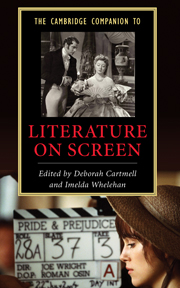Book contents
- Frontmatter
- Introduction - Literature on screen: a synoptic view
- Part One Theories of Literature on Screen
- Part Two History and Contexts
- Part Three Genre, Industry, Taste
- Part Four Beyond the "Literary"
- 13 Classic literature and animation: all adaptations are equal, but some are more equal than others
- 14 High fidelity? Music in screen adaptations
- 15 From screen to text: novelization, the hidden continent
- 16 A practical understanding of literature on screen: two conversations with Andrew Davies
- Further reading
- Index
- Series List
13 - Classic literature and animation: all adaptations are equal, but some are more equal than others
from Part Four - Beyond the "Literary"
Published online by Cambridge University Press: 28 September 2007
- Frontmatter
- Introduction - Literature on screen: a synoptic view
- Part One Theories of Literature on Screen
- Part Two History and Contexts
- Part Three Genre, Industry, Taste
- Part Four Beyond the "Literary"
- 13 Classic literature and animation: all adaptations are equal, but some are more equal than others
- 14 High fidelity? Music in screen adaptations
- 15 From screen to text: novelization, the hidden continent
- 16 A practical understanding of literature on screen: two conversations with Andrew Davies
- Further reading
- Index
- Series List
Summary
There is little doubt even in the contemporary era when animation enjoys a high artistic, cultural, and popular profile, that the combination of high literature - “the classic” - and the “cartoon,” still seems an unholy alliance. One wonders, for example, what director Brad Bird said to Poet Laureate, Ted Hughes, when preparing his adaptation of The Iron Giant (1999) - “Great poetic narrative Ted, but don't you think it's short on chases and custard pies?” This, of course, is to caricature both practices - literature as the embodiment of elevated “art” and animation as a vehicle only for comic events, slapstick, and spectacle. Neither is accurate, and in the case of The Iron Giant, Bird abandoned the more readily “animatable” and spectacular second half of Hughes's narrative to concentrate on the core relationship between a boy and a robot in a quasi-realist cartoon style. Nothing, then, should be taken for granted, and this discussion will seek to explore a range of perspectives on the relationship between classic literature and animation, and will extend a personal preoccupation on this matter. I have written elsewhere, for example, about the technical and aesthetic correspondence between literary practice and the animated form in the process of adaptation, and I have also looked at the ways in which particular kinds of literary criticism may be applied to the analysis of animation, resulting in my own conception of the “subjective correlative.” Both these discussions will be drawn upon and reiterated again here, but the broad intention on this occasion is to explore literary texts for the mechanisms and methodologies which render them suitable for animation, and the ways, thereafter, that animation, in turn, reveals the core intentions, values, and aesthetic outcomes of those texts to best effect.
- Type
- Chapter
- Information
- The Cambridge Companion to Literature on Screen , pp. 199 - 211Publisher: Cambridge University PressPrint publication year: 2007
- 4
- Cited by

